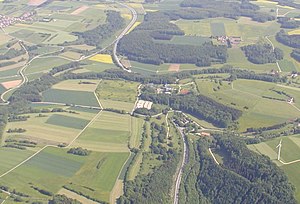Lambs hump tunnel
|
|
||
|---|---|---|
|
Alb ascent of the A 8 between Wiesensteig and Hohenstadt with Lämmerbuckeltunnel (center) and Lämmerbuckel (right)
|
||
| Official name | Lambs hump tunnel | |
| use | Road tunnel | |
| traffic connection | Federal motorway 8 | |
| place | Wiesensteig | |
| length | 625 m | |
| Number of tubes | 1 | |
| construction | ||
| start of building | 1937 | |
| completion | 1942 | |
| location | ||
|
|
||
| Coordinates | ||
| Northwest portal | 48 ° 33 '3 " N , 9 ° 38' 6" E | |
| Southeast portal | 48 ° 32 ′ 50 " N , 9 ° 38 ′ 30" E | |
The Lämmerbuckeltunnel on the northwest flank of the Swabian Alb is a 625 m long and 7.5 m wide tunnel on the Alb ascent of the federal highway 8 near Wiesensteig in the district of Göppingen in Baden-Württemberg . After the Nasenfels tunnel , it is the second oldest motorway tunnel in Germany that is still in operation. A speed limit of 100 km / h applies in the tunnel.
Geographical location
The Lämmerbuckeltunnel, which is part of the two-lane carriageway from Stuttgart to Ulm as part of the federal motorway 8 , leads to an average of about 760 m above sea level. NN through the 800.6 m above sea level. NN high eastern flank of the Lämmerbuckels ( 819.6 m above sea level ), which is mostly unforested between Wiesensteig in the north-northwest and Hohenstadt in the east-southeast.
history
Construction of the two-lane Lämmerbuckeltunnel began in autumn 1937, the tunnel was breached in summer 1938, and the roadway was completed in 1942. After that, however, heavy iron gates were installed at the entrances and the tunnel was converted into an armaments factory for compressors and aircraft engines (Heller and Daimler-Benz ). The location was ideal as this factory was almost invisible from the air and bombproof. A heating system and residential complexes were also set up for this purpose. The property above the Lämmerbuckeltunnel still belongs to the Daimler group, which built a training center directly above the tunnel shortly after the Second World War and still operates it today.
The rest of the ascent of the motorway was only finished in May 1957, so that the tunnel could be handed over to its original purpose.
In 2011 the tunnel was renovated. The interior cladding made of ceramic tiles was removed and security retrofits (video surveillance, emergency call niches, barriers, etc.) were carried out. For the construction work, the Albaufstieg was closed to traffic on several weekends.
From 2018 to 2020, two rescue tunnels, each 140 meters in length, were built. This shortens the escape routes to a maximum of 300 meters.
Individual evidence
- ↑ a b map services ( memento of the original from December 19, 2012 in the Internet Archive ) Info: The archive link was inserted automatically and has not yet been checked. Please check the original and archive link according to the instructions and then remove this notice. of the BfN
- ↑ https://www.welt.de/regionales/baden-wuerttemberg/article214001410/Arbeiten-im-Laemmerbuckeltunnel-beendet.html accessed August 22, 2020


